It’s a wonderful wake up call to meet someone who challenges you to live a fuller life. By example, they prove that we can do more, and have more fun, if we just keep moving.

This past week we had an enthusiastic newbie reader call us and explain that he was having a really hard time selecting his first truck and camper combination. He launched into a laundry list of “this or that” questions; this camper or that, this truck or that, this floor plan or that, this feature or that, and so on.
Clearly our newbie friend was deep into the analysis paralysis swamp, and sinking. When he paused, I said, “For goodness sake, stop reading Truck Camper Magazine! Get out there and experience some campers in person on dealer lots. These questions will start to answer themselves”. He laughed and agreed. Hopefully he’s not reading this article, and is currently sitting in a camper dinette deciding on this camper, over that camper.
What the reader didn’t know is that I had just read Cheryl White’s interview and was still glowing with her enthusiasm for life. Her story has a wonderful and powerful underlying message, “Get out there, and move. Live your life, while you still can”. It’s simple advice and it resonated with me deeply. None of us know how much time we have left, and there’s so much amazing stuff to do out in the world. As the saying goes, “So much to do, so little time”.
Carpe Diem Cheryl! We are inspired.
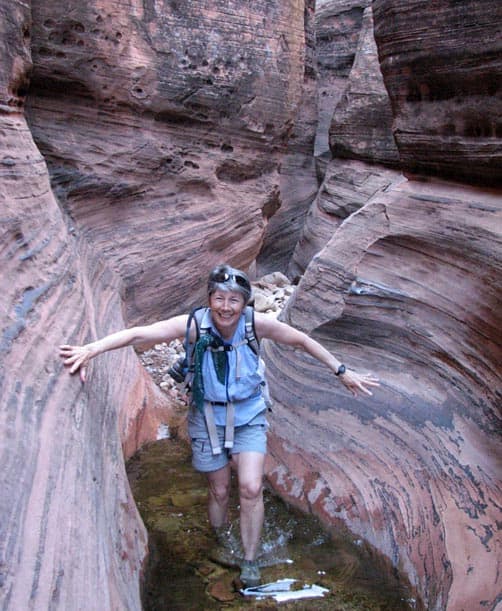
Above: Slot Canyon near St. George, Utah
TCM: How did you get into truck camping?
Cheryl: We first got into truck camping after thirty plus years of tent camping. We wanted something more comfortable than a pad on the ground and tarps over our gear. We started by looking at all the alternative types of RVs. Then, in 1997, we saw a truck camper in Zion National Park. The owners gave us a tour and we were hooked. We were amazed at the room in their camper and that truck campers contained all you could ever need for a trip.
Knowing our love of National Parks and camping in the boonies, we started our hunt for a truck camper. It took a bit of time before we started seriously looking for a big truck to carry the camper load. As luck would have it, we found our present truck with all the bells and whistles, including the camper package, at a great price. We bought it on the spot.
Then began our hunt for a truck camper. Camper shows and visits to dealers became our weekend fun. We found an older model 1992 Lance 900, bought it, and used it for two years. Then we sold it for only $500 less than we’d paid for it.
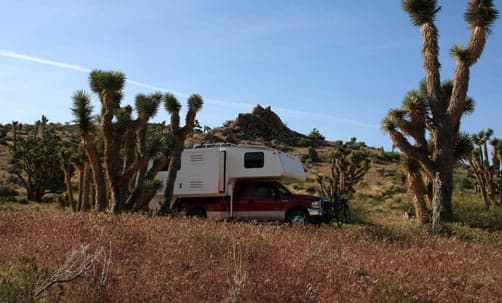
Above: Beaver Creek Wilderness in Utah
TCM: We did almost exactly that with our first truck camper. If you buy right, it’s amazing how well a truck camper can hold it’s value. When did you get your Arctic Fox?
Cheryl: In 2005. The search for a new one actually overlapped the sale of the old one. At that point, we knew a truck camper worked well for us. And knowing we were planning to retire and travel for months at a time, we needed a bit more space than our first camper afforded us. My husband, Ted, is 6’1” and needs moving around space, so the full-wall slide became important. Soon we had located the 2005 Arctic Fox 1150.
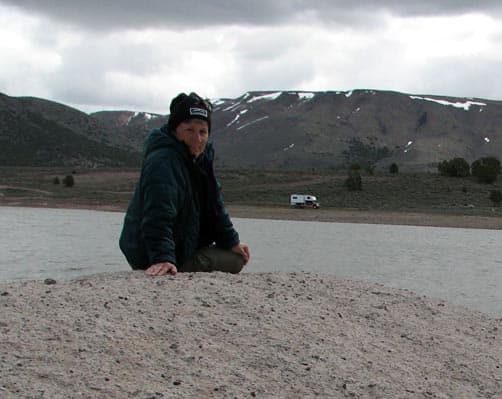
Above: Cheryl White at Honeycomb Rocks, Utah
TCM: Since this is Ladies’ Week, give us a ladies perspective on truck camping. The biggest complaint I get at RV shows from ladies is that there isn’t enough room in a truck camper. What’s your take on that?
Cheryl: For one thing, we always took too much with our first camper. There are always going to be compromises, like less storage. But that also means a smaller house to keep clean. We tend to wear our favorite comfortable clothes, so we choose those for the camper. Life is more simple in a truck camper. We keep trying to complicate things by taking too much stuff! It is really all about priorities. We take the items that enhance our experiences and leave the rest home.
Unless it’s really nasty weather, we’re more likely to be outside. Our truck camper is for cooking and sleeping, for the most part. If the weather or bugs are bad, we go inside and read.
We’ve really made the best use of all of the available storage spaces, in fact, we have found hidden areas behind panels and modified existing areas, removing the never-used microwave in exchange for more food storage, and placed shelves in closets. The kayak gear and a more compact generator is where the larger generator used to be. Paddles and ski poles fit in the tall skinny compartment. Kayaks go on the roof and we added a front roof rack. Or our folding kayaks fit in the truck with ski bags, maps, camera gear and a case of our favorite survival snack bars for hiking. We have relocated our bikes from back ladder rack to a front truck rack. They stay much cleaner and the ladder is now fully accessible.
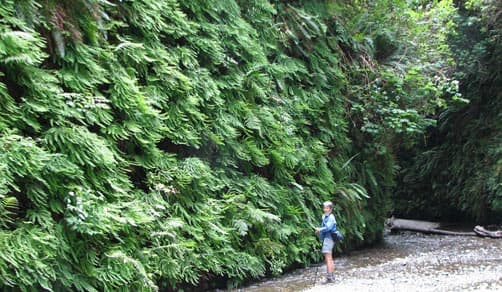
Above: Fern Canyon, California
TCM: What is your role with your truck camper?
Cheryl: I am in charge of food and my own clothing and gear. Ted loads the camper on the truck. I have done it a few times, but Ted is more comfortable doing it. Once on the road, my face is in the map books, a series of Delorme state maps that are very detailed. We do preliminary planning before heading out, but where we actually go is very impromptu. If I see a place that sounds interesting, I say, “Let’s go there”. Sometimes we are disappointed, but usually not. I also drive. We have a fairly strict rule to switch drivers every two hours.
Laundry days are a two person affair. We hate spending time at the laundromat. We have a hand washer. It’s a cone-shaped, plunger-like item with baffles up inside. It fits down in a five gallon bucket which serves as our clothes hamper. With an up and down motion by one of us, the clothes are washed. Then they go through our new hand-wringer which clamps to a picnic table. The clothes are fairly dry after they go through this and are ready to hang. Clothes dry much more quickly in the west. We use laundromats occasionally if we are in areas where we must conserve water.
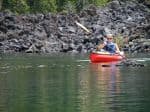 |
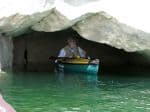 |
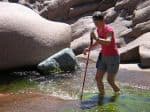 |
TCM: That sounds amazing. What a great idea as long as you have the water and time to let things dry. Do you stay in places for very long?
Cheryl: We tend to stay in places we like for many days; sometimes up to two weeks if there are many hikes that we’d like to do. Diesel prices were high this last trip so we limited our boundaries, stayed in a more confined area, revisited some favorite places, and did the hikes or bike rides we had previously missed. And we finally kayaked Lake Powell with its many water-filled canyons.
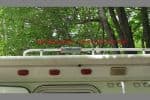 |
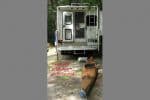 |
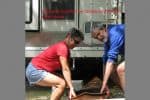 |
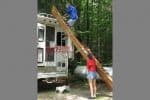 |
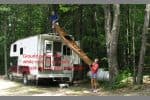 |
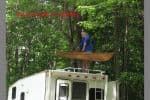 |
Above: Step-by-Step how Ted and Cheryl put their kayak on their Arctic Fox roof
TCM: How do you put your kayak on the camper roof? I’ve gotten emails asking us about that.
Cheryl: We have a piece of foam pipe insulation on the rear roof rack. We both lift the kayak by the cockpit and lean it against this foam padding on the roof. Ted climbs up while I hold the boat steady. He then pulls while I lift from below and the kayak rolls up and is placed in the saddles. Obviously, it is easier with a lighter boat. Ted is now building a fourteen foot wooden kayak to replace my heavier seventeen foot fiberglass boat.
TCM: What modifications have you done to your camper?
Cheryl: Ted has installed solar panels, an inverter, more insulation, two heavier duty batteries, shelves, stronger cupboard latches, hooks on the walls, a magazine rack, etc. There are more modifications and repairs happening right now to ensure a longer camper life.
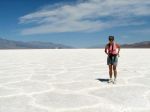 |
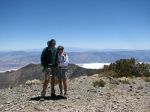 |
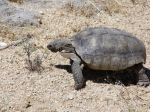 |
TCM: Were you a photographer before, or has traveling sparked this interest?
Cheryl: I was a photographer before retiring, but our trips have definitely increased my interest. I take a DSLR and a smaller point and shoot camera and Ted also takes his. I use a new card each day to help keep the photos organized. With over 35,000 pictures, we need to store them on a large hard drive. My interests are many and varied, from scenery to flowers to wildlife, old buildings, odd rock formations, lizards, and tortoises. We were fortunate enough to be in Death Valley when the flowers were magnificent and to be hiking in Joshua Tree when a tortoise crossed our path.
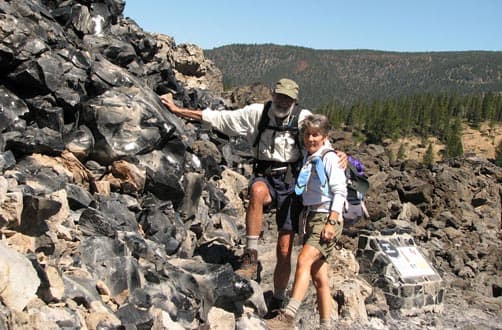
Above: Obsidian flow at Newberry Volcanic National Monument
TCM: You said in your email that you had a love of the National Parks. For a TCM reader who has not been to any of them, which one would you recommend people start at?
Cheryl: All the National Parks we have visited are wonderful, so it would depend on a person’s interests and abilities. We love Bryce Canyon and after three visits have completed all the hikes. In Bryce, you hike down first and must remember that the more demanding climb back up is at the end of your hike. Yellowstone is wonderful for both hiking and shorter sight-seeing walks and drives. Zion is great for long upward hikes that overlook the entire valley, and for biking on trails and roads. All parks offer different adventures and should be researched beforehand to find the one that fits your agenda. Many now have shuttle buses with bike racks and will drop you off at trail heads or scenic overlooks.
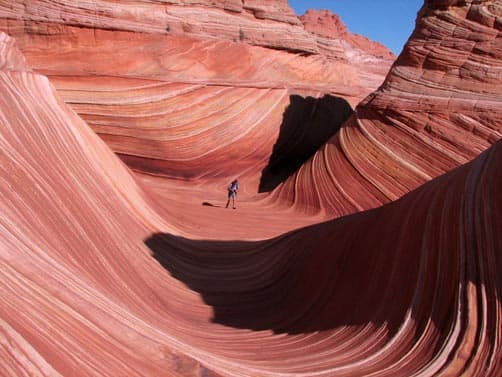
Above: Coyote Buttes, a.k.a. The Wave
Everyone asks us our favorite place. Going to “The Wave” was a dream come true. I was tickled on the fifth day of waiting when our lottery number came up for the permit to go. Toroweap in the Grand Canyon was also a favorite, especially for Ted.
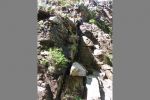 |
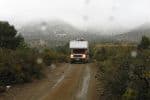 |
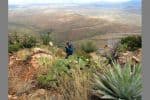 |
TCM: How do you find these amazing places to go hiking? Do you have a guide? And I see it’s not all in red rock country. It’s pretty varied.
Cheryl: Many of our hikes and adventures are from map finds. Some are from truck camper friends and still others are tips from fellow campers. One in particular, which was a map find, took us out a six mile gravel road to the Butterfly Botanical Area in the Plumas National Forest north of Quincy, California. After wandering the area and photographing the fascinating pitcher plants and sundews, I saw that the forest road continued on the map and that it looked shorter than backtracking.
The adventure that followed was actually more like a nightmare. It was a white knuckled drive with roads becoming very narrow, snaking along the side of a mountain high above a ravine with a river below. I was out in front moving rocks out of the way, and once our outside dually wheel was hanging over the edge. There was absolutely no place to turn around. The road could easily be handled by a Jeep, but here we were with an F-350 dually and our 1150 camper! And it ended up being a longer route. Secretly, we had each wondered if there would be a locked gate at the end, or a washed out bridge. By the time we burst through the last of the overgrowth, we had gone through a concrete train underpass that was breaking under our weight. Construction workers at the end looked at us with utter amazement. We had branches, leaves, and forest debris hanging off all parts of our rig and bikes. We were just happy they were waving us through their work zone. It took three weeks before Ted could write about it on our blog.
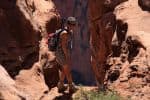 |
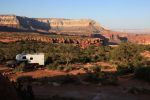 |
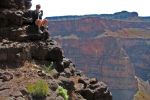 |
TCM: That sounds completely insane. What is Toroweap?
Cheryl: Toroweap, also known as Tuweep, is a secluded section of the Grand Canyon approximately 140 miles west and down river of the more popular North Rim. It is reached via sixty-one miles of gravel road, the first twenty-five miles being quite well maintained. The remaining miles deteriorate the farther you go. The drive takes about three hours, the last three miles taking about forty-five minutes over slick rock and sharp curves. Ted has wanted to go there since childhood, so off we went. We had talked to several people who had just come out the road and said it was in good shape. Toward the end, we encountered two large boulders about nine feet apart, our rig being eight feet wide. I hopped out just to make sure we could make it through. With Ted’s very skilled and cautious driving, we made it to the campground and found one site left on the upper level.
The campground is in a beautiful setting, but has no services, only a picnic table and fire ring at each site and two small buildings with two composting toilets each. It’s our kind of place! Three sites are up above and the other seven are down a pitch over crumbled slick rock. You don’t have any way of knowing if there are open sites ahead of time. The ranger station is six miles back. If there are no spaces, you have to return to that point and find dispersed camping. We were amazed at how many people went to all the time and effort to get there and set up camp and then leave the next day. We stayed six days.
The canyon is a short walk away and impressive with it’s 3000 foot drop to the river. There are no paved walkways or safety rails. You are in the canyon and on the edge. The hikes are on sand and slick rock. The scenery is magnificent and the view from our back door was incredible. A metal box holds brochures with descriptions of the hiking trails available. One trail is to Lava Falls, one of the most difficult sections of rapids for rafters. We had gone out for a long bike ride that was five miles to the trailhead over rough roads. We didn’t really know that this was where we would end up, so we were not properly equipped for this difficult and strenuous hike. In our sneakers and biking clothes, we did a brief exploration a short ways down, enough to tell us we would have to return to do that hike. It is the shortest route to the river, which is one and a half miles down over lava and cinders, so it’s very steep and exposed, with much loose footing and no available water.
There are many such wonderful places, accessible only by rough dirt roads, but with great rewards, like Cottonwood Canyon or House Rock Valley Road.
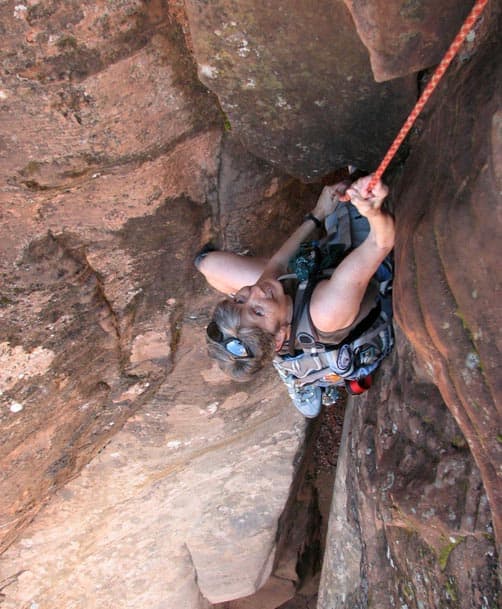
Above: Red Cliffs BLM, Utah
TCM: I was emailing with past Ladies’ Week interviewee, Anne Brown, the other day and told her that I was interviewing you for our next Ladies’ Week. She said, “Ask her about her technical rock climb up a rock chimney”.
Cheryl: I am not sure that the climb I did would be considered technical, but it was definitely out of my comfort zone. We were camped at Red Cliffs Campground, near Hurricane, Utah. We had heard of a loop trail, but no one seemed to know how to get to it. The camp host is a Utah raised desert rat with amazing skills on slick rock. He thought he had found the way to this hike, so four of us headed off to try it. At one place, we split to explore two different routes. When we came to a rock wall, Dave starts up, feet on one wall, back pressed to the other as he worked his way up to a fixed rope. He urged me to follow, but my 5’4” frame left me far short of reaching the rope. He came back and instructed me on how to do this climb. Once reaching the rope, I was able to pull myself up using the knots along the rope. It was exhilarating.
TCM: Sounds terrifying, and fun. Which feature of your truck camper would you not want to give up?
Cheryl: I would not want to give up any of the features. Our truck camper is our home away from home. The total package combines all the features that make it work so well for us. The four wheel drive allows us to go up and over mountain passes in most weather conditions. We love the road less traveled and the truck allows for that, with a few exceptions. Once we find that great campsite, the camper completes the package. We can get to the places many others cannot go, where photo opportunities and hikes are limitless and truly awesome. And our home is with us.
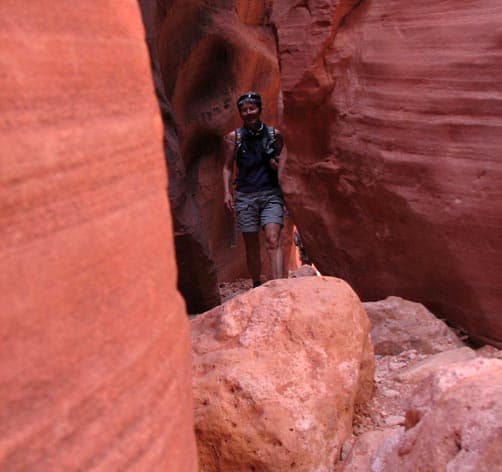
Above: Buckskin Gulch Slot Canyon
TCM: How do you find these remote campsites on the edge of a cliff or deep in the redwood forest?
Cheryl: Again, many of our favorite campsites are found by accident or tips from friends or maps. It is the exploration to find them that is so rewarding. There are many dispersed sites behind gates that simply say, “please close gate behind you”. BLM land is public land, so ours to use and respect. The Delorme maps show where these areas are.
TCM: You, like us, live on the East Coast, and seem to camp out in the West. Do you camp here in the East a lot? If so, where do you like to go on your East Coast adventures?
Cheryl: We camp in Maine along the coast where kayaking is good. Recompence, in Freeport, is where we have gone since our kids were little and is also where Anne Brown has her late fall mini North-East truck camper rally. We also enjoy Cobbscook, far to the north in Maine where kayaking is exceptional. We have spent much time in the White Mountains, Evans Notch being a favorite. We will head up to Prince Edward Island and Nova Scotia again this fall to share in the 400 year celebration of wine making in Bear River. Some other truck camper friends will join us there.
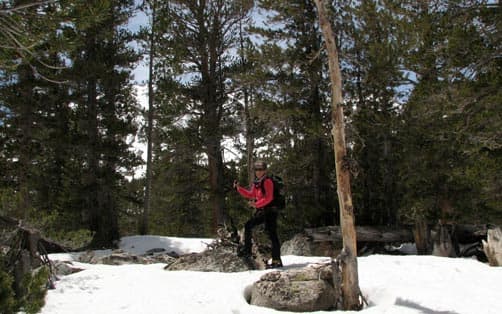
Above: Hike to Grass Lake in the Sierras
TCM: Is there anything you’d like to add to your story that I didn’t ask you about?
Cheryl: I think one thing we thought most about when we approached retirement was our health. Staying physically fit has been our greatest asset. It was nice to have our debts paid off, but having our health has allowed us to do all these great adventures. Our country is an amazing place and many people see only a fraction of it, some only the state where they were born. Pay attention to your health and fitness, then get out there and do it and create your own adventure stories.
TCM: Gordon made a similar point about health in a May blog on fuel prices, “Reality Check: Fuel Prices By Damned”. He said that it’s health, not money, that often runs out. Thanks for sharing your story Cheryl, and participating in Ladies’ Week 2011!
Cheryl: You’re welcome.
Cheryl and Ted White’s Truck Camper Rig
Truck: 2003 Ford F-350, extended cab, dually, long bed, 4×4, diesel
Camper: 2005 Arctic Fox 1150
Jacks: Happijac jacks
Tie-Downs/Turnbuckles: Home made truck frame attachments with Torklift Fastguns
Suspension: Airbags, but don’t use them, standard overload springs
GEAR: Solar enhanced 225 watts, insulation, AGM batteries can lay on side, inverter, Verizon Mifi
